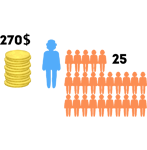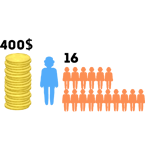Poverty
This module encounters the multi-faceted nature of poverty in both, developing and industrialised countries
Education
„Aid and debt relief are not a silver bullet, they are an important element of the package, but I don´t even think the most important element of the package. Debt relief was just the first step.“ Shriti Vadera in „Give us the money“
In the movie "Give us the money", Shriti Vadera and Mariémme Jam criticize trying to combat the economic issue of poverty purely by debt relief for developing countries. Birhan Woldu is also of the belief that it takes more to move along the path out of poverty:
„We need to build more schools, because there are still many places that don´t have any school buildings. If we can do this, the country will continue to develop.“
Poverty prevents education and education prevents poverty, the relationship between poverty and education can be viewed this way. People living in extreme poverty in developing countries often have no access to education. The reasons for this are varied, ranging from the absence of schools and poor equipment to financial barriers up to teacher shortages. But also people affected by relative poverty in welfare states frequently suffer from a lack of education. In Austria education poverty is inherited as it always was, the socio-economic situation at home decides much about the education of the child. Lack of empowerment goes hand in hand with a lack of knowledge. Empowerment means that I believe in myself, that I have rights and that I am aware that I can build my life with my skills.
Task
Try to draw the network of issues on a piece of paper.
Public expenditure on education allows a state to establish, among other things schools, to create teaching materials, teacher training and to make and deliver meals to schools. Globally, in the field of public spending on education there are large geographical differences.
Task
Match the geographical terms to the pictures. The money in each figure represents public expenditure on education per inhabitant; people symbolize the ratio of primary school pupils per teacher.







Sources
Immel, Karl-Albrecht/ Tränkle, Klaus (2001): Aktenzeichen Armut. Globalisierung in Texten und Grafiken. Wuppertal: Peter Hammer Verlag
http://junge-gruene.at/blog/2011/12/13/die-illusion-von-der-chancengleichheit-wie-bildungsarmut-vererbt-wird/
http://www.armut.de/aspekte-der-armut_ursachen-und-folgen-der-armut_mangel-an-bildung-und-ausbildung.php?mysid=o6u61sfrh3nsld0i8qiegaf40gdvgaut
